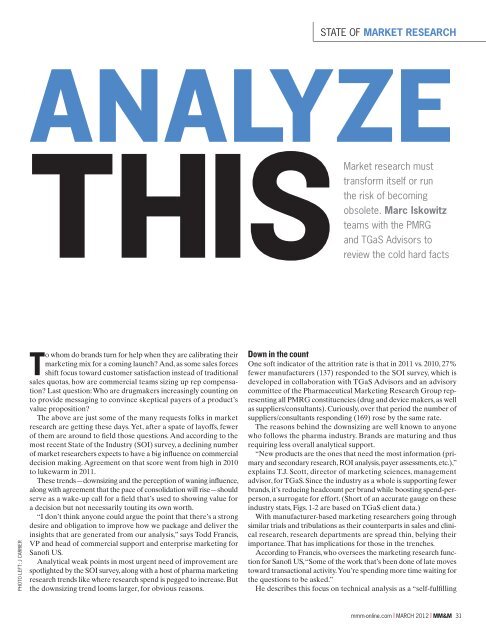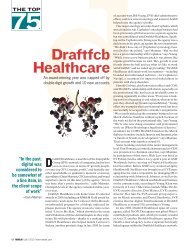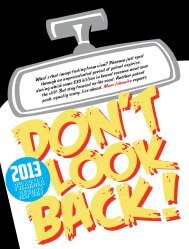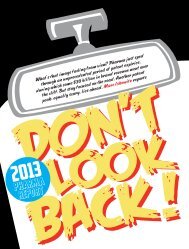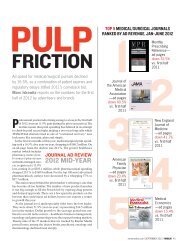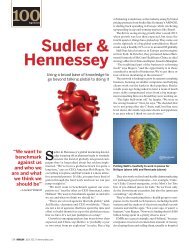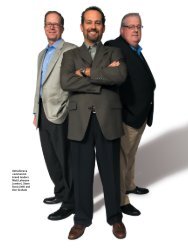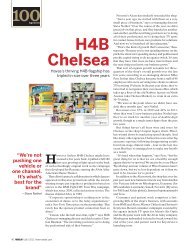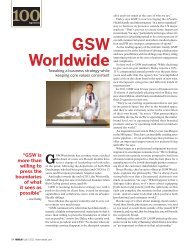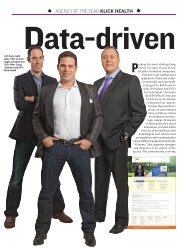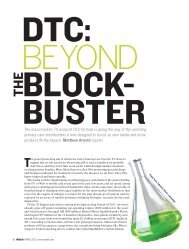Analyze this - Medical Marketing and Media
Analyze this - Medical Marketing and Media
Analyze this - Medical Marketing and Media
You also want an ePaper? Increase the reach of your titles
YUMPU automatically turns print PDFs into web optimized ePapers that Google loves.
PHOTO LEFT: J CARRIER<br />
STATE OF MARKET RESEARCH<br />
ANALYZE<br />
THIS<br />
To whom do br<strong>and</strong>s turn for help when they are calibrating their<br />
marketing mix for a coming launch? And, as some sales forces<br />
shift focus toward customer satisfaction instead of traditional<br />
sales quotas, how are commercial teams sizing up rep compensation?<br />
Last question: Who are drugmakers increasingly counting on<br />
to provide messaging to convince skeptical payers of a product’s<br />
value proposition?<br />
The above are just some of the many requests folks in market<br />
research are getting these days. Yet, after a spate of layoffs, fewer<br />
of them are around to field those questions. And according to the<br />
most recent State of the Industry (SOI) survey, a declining number<br />
of market researchers expects to have a big influence on commercial<br />
decision making. Agreement on that score went from high in 2010<br />
to lukewarm in 2011.<br />
These trends—downsizing <strong>and</strong> the perception of waning influence,<br />
along with agreement that the pace of consolidation will rise—should<br />
serve as a wake-up call for a field that’s used to showing value for<br />
a decision but not necessarily touting its own worth.<br />
“I don’t think anyone could argue the point that there’s a strong<br />
desire <strong>and</strong> obligation to improve how we package <strong>and</strong> deliver the<br />
insights that are generated from our analysis,” says Todd Francis,<br />
VP <strong>and</strong> head of commercial support <strong>and</strong> enterprise marketing for<br />
Sanofi US.<br />
Analytical weak points in most urgent need of improvement are<br />
spotlighted by the SOI survey, along with a host of pharma marketing<br />
research trends like where research spend is pegged to increase. But<br />
the downsizing trend looms larger, for obvious reasons.<br />
Market research must<br />
transform itself or run<br />
the risk of becoming<br />
obsolete. Marc Iskowitz<br />
teams with the PMRG<br />
<strong>and</strong> TGaS Advisors to<br />
review the cold hard facts<br />
Down in the count<br />
One soft indicator of the attrition rate is that in 2011 vs. 2010, 27%<br />
fewer manufacturers (137) responded to the SOI survey, which is<br />
developed in collaboration with TGaS Advisors <strong>and</strong> an advisory<br />
committee of the Pharmaceutical <strong>Marketing</strong> Research Group representing<br />
all PMRG constituencies (drug <strong>and</strong> device makers, as well<br />
as suppliers/consultants). Curiously, over that period the number of<br />
suppliers/consultants responding (169) rose by the same rate.<br />
The reasons behind the downsizing are well known to anyone<br />
who follows the pharma industry. Br<strong>and</strong>s are maturing <strong>and</strong> thus<br />
requiring less overall analytical support.<br />
“New products are the ones that need the most information (primary<br />
<strong>and</strong> secondary research, ROI analysis, payer assessments, etc.),”<br />
explains T.J. Scott, director of marketing sciences, management<br />
advisor, for TGaS. Since the industry as a whole is supporting fewer<br />
br<strong>and</strong>s, it’s reducing headcount per br<strong>and</strong> while boosting spend-perperson,<br />
a surrogate for effort. (Short of an accurate gauge on these<br />
industry stats, Figs. 1-2 are based on TGaS client data.)<br />
With manufacturer-based marketing researchers going through<br />
similar trials <strong>and</strong> tribulations as their counterparts in sales <strong>and</strong> clinical<br />
research, research departments are spread thin, belying their<br />
importance. That has implications for those in the trenches.<br />
According to Francis, who oversees the marketing research function<br />
for Sanofi US, “Some of the work that’s been done of late moves<br />
toward transactional activity. You’re spending more time waiting for<br />
the questions to be asked.”<br />
He describes <strong>this</strong> focus on technical analysis as a “self-fulfilling<br />
mmm-online.com x MARCH 2012 x MM&M 31


